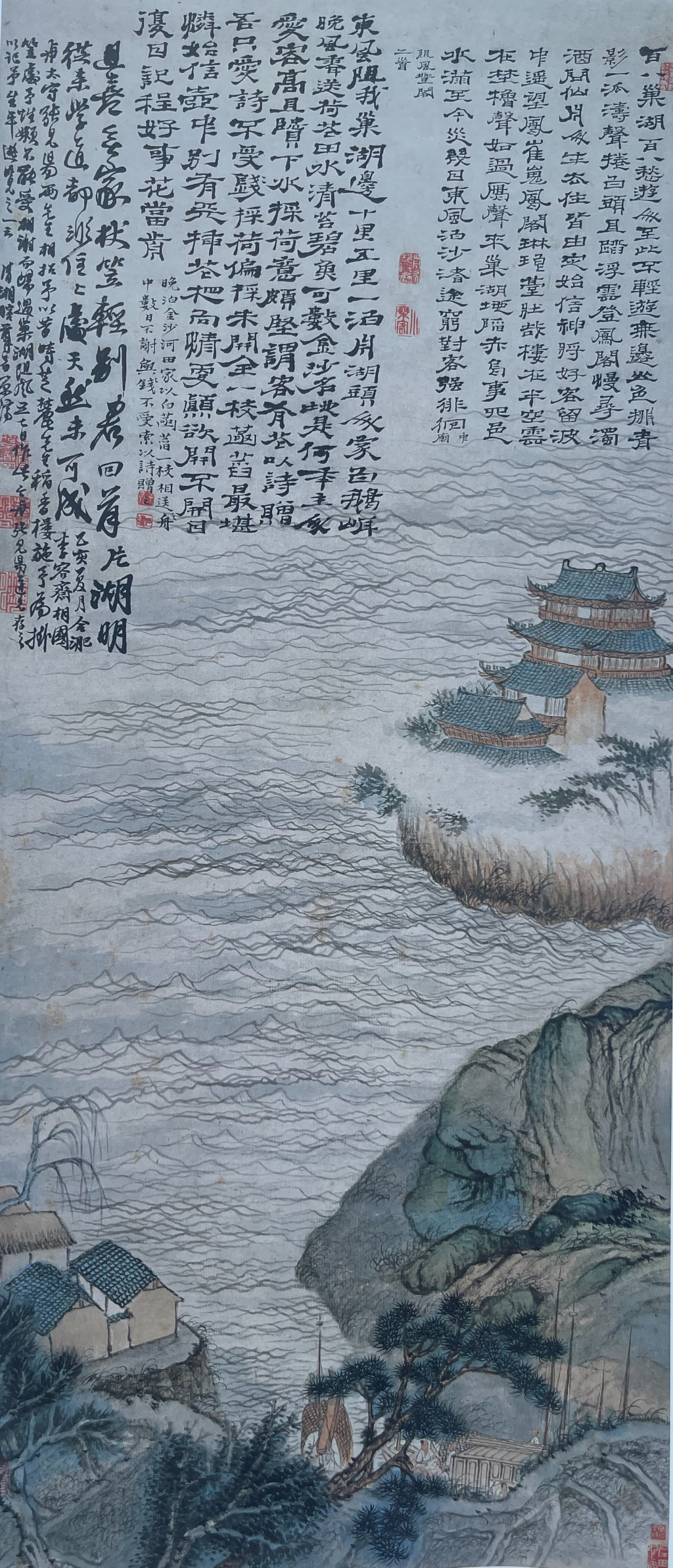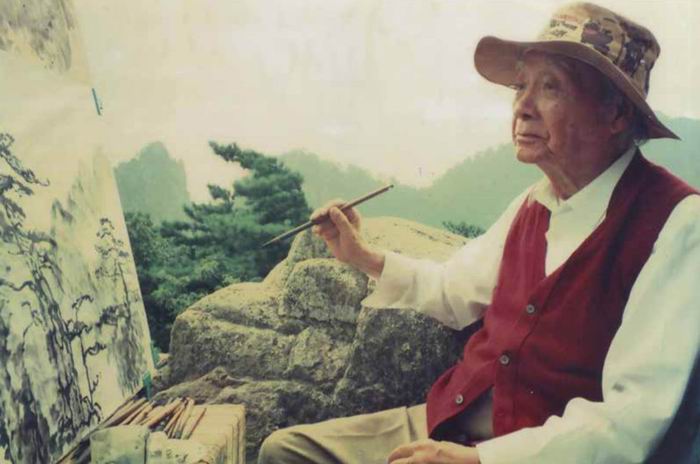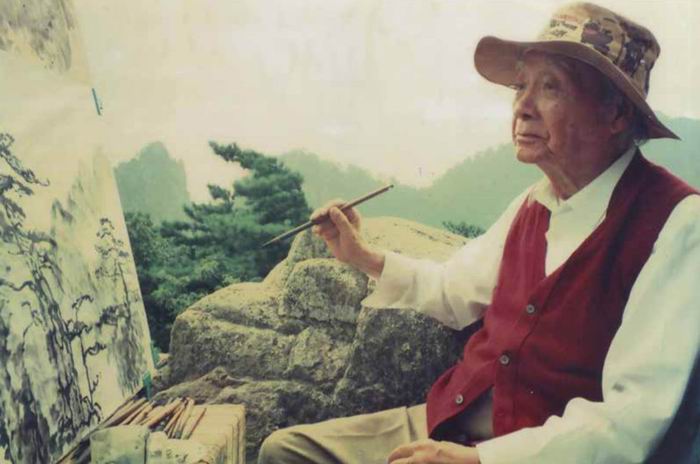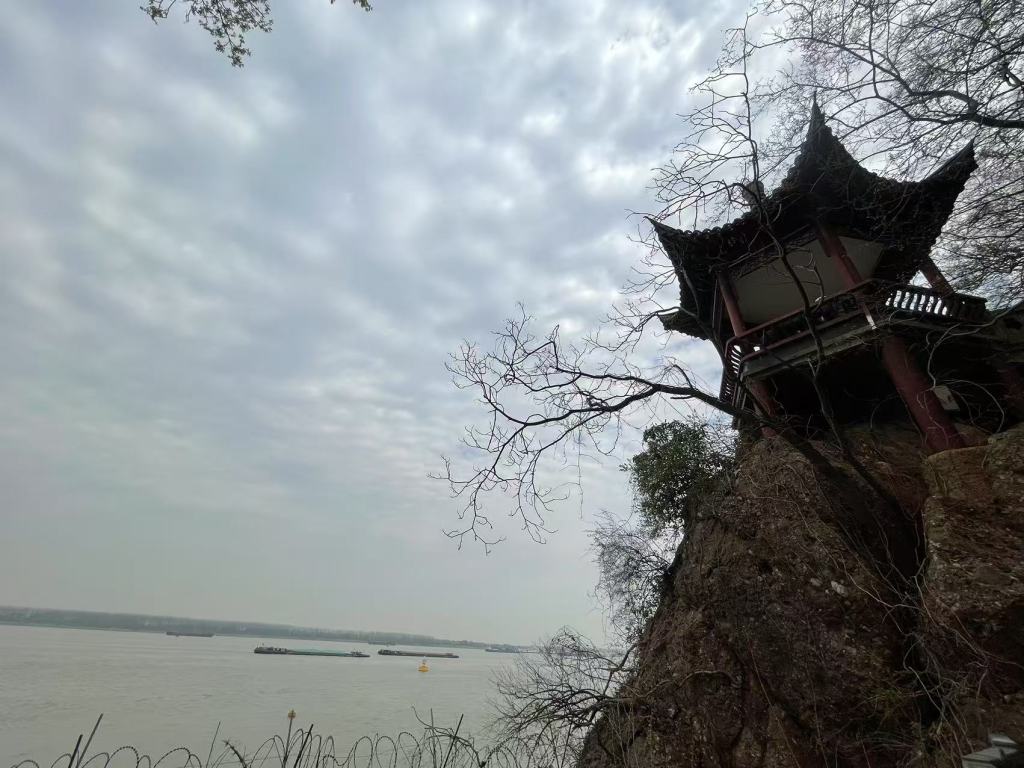
The river surges eastward, its mighty roar nourishing civilization. The Paper's "Cultural China Tour: The Cultural Heritage of the Yangtze River" departs from Shanghai and journeys up the Yangtze River, exploring its cultural heritage along its banks.
This issue visits Chaohu Lake in Anhui Province, where Shi Tao's "Chaohu Lake Map", a masterpiece in Chinese art history, was created, and we experience the changes and constants inside and outside the painting over the past three hundred years.
More than ten years ago, I first encountered Shi Tao's "Chaohu Lake". I fell in love with its misty waves and the line "I am glad I have no home and my walking stick and hat are light". I saw it without knowing how vast the world was. However, I never thought that one day I would really walk into such a painting. Moreover, it is said that although more than three hundred years have passed, the Chaohu Lake described by Shi Tao and the real Chaohu Lake have not changed much. In an era of rapid change, it is almost unbelievable.
(one)
"Chaohu Tu" is a representative landscape painting of Shitao in his later years, and is also the earliest existing masterpiece depicting the scenery of Chaohu Lake. It was created because his boat was stranded by wind on Chaohu Lake and he was moved away by the kindness of the Tian family who gave him lotus. It combines poetry, calligraphy and painting on one piece of paper and is now in the collection of Tianjin Museum.
In the summer of the 34th year of the reign of Emperor Kangxi (1695), 53-year-old Shitao accepted the invitation of Zhang Jianyang, the prefect of Luzhou (present-day Hefei, Anhui Province), and stayed there for several months. On his way back to Yangzhou by sea, he planned to board a boat from the Nanfei River, pass through Chaohu Lake, and then sail down the Yangtze River. However, the boat had not far to sail when it encountered wind and rain. As the saying goes, "The east wind blocked our way to Chaohu Lake, and we had to moor every five or ten miles." Consequently, the boat had no choice but to anchor in a bay called "Jinjiahe" near the Zhongmiao Temple in Chaohu Lake. There, heavy rain fell, and the boat remained there for several days.
During his stay at Chaohu Lake, Shitao ascended a pavilion to gaze at the lake. A local farmer waded through the water to gather unopened white lotuses as a gift, refusing payment and instead requesting a poem as a souvenir. Impressed by his noble character, Shitao commemorated the event with a poem: "The host cherishes his guest's noble and virtuous character, and is determined to descend into the water to gather lotuses. He offers flowers as a gift in exchange for a poem, but I only appreciate poetry and will not accept payment." The poem, "A single lotus branch is most pitiful," further expresses his admiration for the local customs. This refined demeanor would later become the essence of his painting: the farmer exchanged a poem for the lotus, the monk painted a painting of the lake to express his gratitude, and intended it for Zhang Jianyang as a token of his appreciation for his kindness, expressing the vastness of the lake and mountains and the warmth of humanity. Unexpectedly, this work has survived to this day and has become a classic in the history of Chinese art.

Chaohu Lake, a representative landscape painting by Shi Tao in his later years

Chaohu Lake Today
Shi Tao broke through the traditional panoramic landscape and adopted a "truncated" composition, taking a corner of the lake bay and unfolding it in layers.
The farmland and thatched houses in the foreground are the Baiyi Temple where the artist lives. The pine trunks are outlined with dry brush and burnt ink, like the wild and strong pines of Huangshan Mountain, while the willows and other trees are blurred with wet ink. In between, there is a pier on the shore with masts lined up, indicating that the ships are stopped in the harbor due to wind resistance. Among the three people moored in the boat, there is a monk sitting cross-legged, perhaps a metaphor for himself.
The mid-ground depicts the vast expanse of the lake, using "fishing net" texture lines to depict the waves. The overlapping of thick and thin lines creates a sense of surging waves, dense like the overlapping of seal and clerical scripts, sparse like flying white, and translucent. The waves rise and fall with the shore, and near the boat, the waves surge like a struggle. In the distance, the towering ancient temple appears, seemingly rising and falling with the waves. The three-story Phoenix Pavilion is fully displayed, its base painted with light ink, hidden in the mist, creating an illusion of "the temple foundation appears and disappears." Further in the lake, Laoshan Island is depicted, rather than its form, in the form of poetry, representing the actual scene.
What is particularly worth noting is that Shi Tao wrote three sets of poems inscribed on his painting "Chaohu Lake", written in official script and running script respectively.
The first group is inscribed in official script, recording the boat reaching the Zhongmiao Temple and climbing the pavilion after the wind stopped. They include:
"The 108th Chaohu Lake is filled with sorrows, so visitors shouldn't take it lightly when visiting here.
The boundless mountains are lined with green shadows, and the sound of waves rolls up the white hair."
"The Chaohu Lake sank during the Chiwu Incident, and the four counties were flooded, causing disasters to this day.
For a few days the east wind has been blowing on the sandbanks, and at the end of the road I am forced to linger with my guests."
The second set of inscriptions is also in official script, but is more unrestrained than the first set. It begins with:
"The east wind blocks my way to Chaohu Lake, where I moor my boat every five or ten miles.
The lakeside houses are lined with white geese, and the evening breeze carries the fragrance of the lotus fields.
The postscript after the poem records that when the boat was moored at Jinsha River at night, the farmer gave the boat a branch of white lotus as a gift. After several days, the farmer did not thank the farmer and refused to accept the money he was offered. So the farmer asked for a poem in return.
The third group records the return journey, with the wind stopping and the boat moving, written in cursive script, showing the joyful feeling:
"I am glad I have no home, my walking stick and hat are light, when I look back after bidding you farewell, the lake is bright.
Learning the Dao is never about dwelling, and dwelling is not something that can be achieved naturally."

Long postscript at the end of Chaohu Lake painting
A lengthy inscription at the end of the painting further explains the origins of the creation. The composition and inscription seamlessly connect the near, middle, and distant perspectives, weaving them together through the ripples of water, creating a symbiosis of movement and stillness, and a vast expanse of waves. The content and style of the poem inscribed on the painting shift with the context. The value of "Chaohu Tu" lies in its emphasis on sketching, blending documentary and freehand brushwork. Its application of painting quotations and the theory of "similarity in dissimilarity," including the phrase "The study of the Tao is never about dwelling," alludes to Shi Tao's Zen painting philosophy of "not clinging to form," demonstrating the profound significance of Shi Tao's principle of "brush and ink should follow the times" in his imitation of ancient styles in the early Qing Dynasty.
(two)
More than ten years ago, because I loved "Chaohu Map", I visited it and yearned for it, but I almost never thought that I would visit "Chaohu Map" by Chaohu Lake.
That day in Hefei, Chen Mingzhe, vice president of the Anhui Academy of Poetry, Calligraphy and Painting, said, "If I could only recommend one cultural attraction in Hefei, it would be to visit Chaohu Lake and look for the Chaohu Tu (Map of Chaohu Lake)," a painting that depicts the lake's scenery.
This was a pleasant surprise. Later, with his guide, together with Liu Chunjie and Wang Li, we finally visited the Baiyi Temple and Zhongmiao Temple described by Shitao when he lived in Chaohu.
Traveling south from Hefei, I feel that this city can be described as "turned upside down". The current city is probably dozens of times the size of the old city of Luzhou. High-rise buildings rise up along the way, with glass curtain walls that are dazzling, and extend all the way to the shore of Chaohu Lake.
Shi Tao painted "Chaohu Tu" at Chaohu, about a hundred miles from the center of Hefei. As he approached Zhongmiao, the fields outside the car window finally began to ripple with the green of new wheat, a reminder that this was the far suburbs. Nearing the lake, reeds swayed on the shore, and in the distance, the lake, a vast expanse of sky, clouds, and shadows, stretched across it.
We first arrived at Zhongmiao Temple. When we parked the car, we suddenly heard a sad and mournful singing voice. We looked up at the lake and saw a loft with red walls and green tiles standing on the water's edge, just like the distant view in the "Chaohu Map", with almost no difference - this temple, which is more than a thousand years old, has undergone many renovations and still retains the architectural style of the Ming and Qing Dynasties.

Zhongmiao Temple Gate
There is a square next to Zhongmiao Temple with a stage. When I walked over, I found that a troupe was performing an opera. The sad sound when the car stopped came from there - Chen Mingzhe told me that it was Lu Opera.
Such scenes of listening to opera in the countryside have long disappeared.
Lu Opera, commonly known as "Daozi Opera," is melancholy and often lamentable. It's sometimes described as "using sadness as beauty and music to express sorrow," seemingly sharing similarities with the sorrowful and desolate Huai Opera. A female actress in a qingyi costume weeps on stage, her sleeves brushing the edge of the stage. Her mournful, "ten-mile sigh" aria is deeply moving.

Lu Opera performance
The performers sing with such sincerity, for the pain they bear is etched deep within the audience. The lake dwellers fish, farm, and combat flooding; life is like the waves of Chaohu Lake, its ups and downs unpredictable. The joys and sorrows of the play, whether pleading for human redress or redressing injustices or appealing for life's meaning, are bound to resonate deeply.
Most of the people in the audience were elderly people, wearing straw hats, sun hats, or towels under the scorching sun, and densely surrounded the stage. There were old ladies with their toothless mouths open, with a look of concentration on their faces, and old men with white beards and brows, listening quietly with their chins in their hands. There were also people walking nearby, riding motorcycles, transporting goods, and eating snacks, who just parked their cars casually and sat or stood. Most of them were villagers who brought their own benches and stools, who had already grabbed seats and were sitting comfortably; under the shade of the willows by the lake, there were also some audience members scattered around - because they were far from the stage, they were there purely to listen to the opera.
(three)
Enter the Zhongmiao Temple.
Surrounded by water on three sides, this ancient temple is known as Chaohu's "most scenic spot between lake and sky." Perched on the ochre rocks of Fenghuangtai on the lake's north shore, it derives its name from its location "between Chaozhou and Luzhou," resembling a phoenix head proudly reaching into the 800-li sea of mist. Construction began in the second year of the Chiwu reign of the Eastern Wu Dynasty, making it over 1,700 years old.
The red sandstone rocks have been eroded by waves for thousands of years and are full of caves. When the tide rushes in, the sound is like the ringing of a bell - probably because the wind is strong, the water of Chaohu Lake is one wave after another, just like the excitement described by Shitao.

Zhongmiao Temple, surrounded by water on three sides, is known as the "most beautiful place in the world" in Chaohu Lake.
The temple was rebuilt in the 15th year of the reign of Emperor Guangxu (1868-1912), with funds raised by Li Hongzhang of Hefei. The three courtyards and approximately ten rooms reflect the lake's light. The gray brick, white walls, wooden beams, and brackets exude a sense of fortitude and stubbornness. Near the entrance lies a well, known as the "Tianhu Well." Its deep mouth reveals the shimmering waters. Legend has it that the well leads directly to the center of the lake, and that the lake will meow when it mourns, though this remains unknown.
There are many palaces and pavilions, with plaques hanging high, such as "Pengdao Island on Earth", "A Different Lake and Sky"... There is also a plaque that says "Rescuing the Cry of Suffering", written in Li script, with heavy ink and dim gold paint.

The plaque "Seeking the Cry and Rescuing the Suffering" at Zhongmiao Temple
Climb up the winding wooden stairs to the Sutra Repository. The pavilion is not big, but the view is extremely broad: the lake is vast, the smoke reaches the sky, and the boats are as small as mustard seeds, floating up and down.
As far as the eye can see, Laoshan Island in the center of the lake resembles a floating green snail, the shadow of a tower looming, the embankment in the distance winding like a line, and the village and fields all blurred into a faint ink smudge. On the other side, the stage has become a small box, and the audience below is like dots of ink, clustered together.
(Four)
In Shi Tao's "Chaohu Lake View", Zhongmiao Temple is in the distance. Judging from the perspective of the painting, he was sketching at Baiyi Temple not far away - that is, the tiled house and ancient tree in the lower left corner of the painting.

Copy of "Chaohu Lake" (detail of Baiyi Temple). Gu Cunyan, 2012
Just a few hundred meters west along the lake, you can see a curved harbor, which is consistent with the one in the "Chaohu Map". It may be the place where Shitao tied his boat. The lakeshore is rough with sand dunes, reeds and rushes rustle, and occasionally water birds fly over the waves.
Next door is the White Clothes Temple, also surrounded by the lake on three sides and a bamboo forest in front of the gate. Pushing the door open, I found that the temple had been abandoned for a long time, with only a few stone foundations remaining. Two or three new temple buildings had been built in the area, and it had been renamed Guanyin Zen Temple.
After a few people walked by, I didn't know whether to describe it as desolate or novel.

Baiyi Temple Lakeside

Baiyi Temple looking towards the Central Temple
When we walked to Jiao Lao Jing by the water, and looked towards the Zhong Temple, we saw the old willows on the bank near the shore, the vast lake in the middle, and the red pavilion of the Zhong Temple in the distance. It was like a painting by Shi Tao, "Chaohu Lake", right before our eyes. After more than three hundred years, it was really not much different.
The sound of wind passed by my ears, carrying with it the sound of waves, the cry of seagulls, and a hint of the sad tone of Lu Opera, which came faintly, tenacious and endless - only then did I realize that the sad tone of Lu Opera had always been with me.
July 2025


